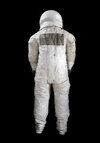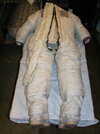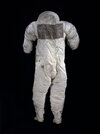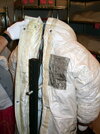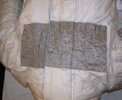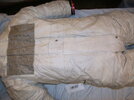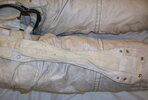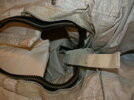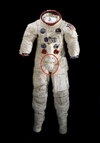I agree.I have an interesting question, it's somewhat related to the issue of bulking the suit.
I have not seen an Apollo replica suit that looks exactly like the real suits, even Global Effects or Ryan Nagata's work, which I consider the absolute peak of replica work, still looks off and doesn't quite match up to the original suits. They always look somewhat airbrushed, a little too clean, even when they're caked in "moon dust"
Is it an issue of fabrics? Weathering? Or is there just some intangible barrier separating real suits from replicas? I don't believe it's an issue with camera quality, I've seen photos of both kinds of suits taken with a variety of lenses and mediums, I don't think it's that related to the pressurized look or the bulk of the suits. I know that the A7Ls and pretty much every subsequent suit uses beta-cloth, which isn't available to the public, but I can't imagine that that would be the issue.
View attachment 1826299View attachment 1826300
Both of these suits were made by Ryan Nagata. they look as close to the real thing as I could imagine, but there's still something wrong.
If you look at some of Kokanee's photos from January, you'll see the difference.
The replicas always look smoother, less wrinkled and less textured, and it always throws me off.
Maybe this is something, maybe I'm making a big deal about nothing, either way, this seems odd to me.
The fabric on many suit replicas is some type of synthetic, such a Nylon pack cloth. On our top level replicas, we use Teflon fabric.
The Teflon fabric we use is pretty close to the Betaglass but not as stiff.
Also, it's not that "It's not available to the public" , More the case is, the cloth made today, is not made exactly the same as the Apollo fabric, and not usually an "in stock" material.
The Betaglass was Teflon coated fiberglass, and didn't like being folded 180 degrees. So over time these seams start to fail, and for a rental suit, this is not desirable.
So this subtle difference, effects the look. The Betaglass catches the light a bit different and being stiffer, it lays differently. But given the durability issue, we have little choice here. The Teflon however, is a much better choice than packcloth. It is however, expensive. Around $120/yrd.
Another issue is the real restraint layer (The working part of the suit under the white cover) has many pieces of hardware that allow the suit to function.
We have used a couple of things to replicate the hardware under the cover layer and in my opinion, it's never really good. The rings of Tygon tube and fiberglass "Boning" have worked for the arm bearings and some of the cable runs, but the big difference is the cable guides in the shoulders. None of the replicas I have seen get this completely right (see below)
One other issue we had, is our LEEVA helmet was too big. I think our early helmets were about 3/4" to large. This affected the proportions of the suit, and made the shoulders look narrower.
The most common mistake with helmets is people make them spherical. Real helmets are almost all narrower side to side than front to back. Tiis is because the human head is not spherical, and designers try to reduce the volume of helmets as much as possible, to reduce the volume of pure oxygen and better control CO2 washout. (Getting rid of exhaled gas)
Because I understand this real engineering requirement, I can't take seriously most move helmets which are often enormous.
The other issue, is when the real suits are pressurized, they do get considerably larger / bulkier looking. We have tried a number of systems to replicate this, because creating a suit which can be sealed and pressurized brings with it way too many problems and issues with filming a movie, with actors.
For "Space Cowboys" we created balloons for the arms and legs, that went around the actors limb's and inflated between them and the suit. It looked very good, but increased to heat on the actor and made working with the suit more time consuming. On "For All Mankind" we used a couple of system, and they worked OK.
Here are two good images to compare. The first shot is our Apollo suits from "First Man" and the second shot is of the real Apollo 11 crew during a training exercise (No mission patches on the suits)
Our suit I feel, are very good overall, but I would have adjusted the shoulder stiffener upwards, in order to get the shoulders squarer. This squareness is caused by the metal cable guides for the shoulder articulation.
This is the real cable guide in the should of the suit.
We really should have fabricated a piece to be sewn into the restraint layer on the shoulders to better replicate this look.
We were really pressed for time on this show however. (First Man)
We were originally contacted in The end of April, and were asked to quote a number of suits. We were told at the time, they were not filming until mid-December or mid-January, but they wanted to get started ASAP. We agreed.
They originally ordered 6 Gemini suits, 1 XMC-2 pressure suit, and 6 Apollo A7L suits. They would also utilize suits from our rental stock.
This order was increased eventually to 9 Gemini, 9 Apollo and the X-15 suit.
We kept asking for money to start, and it wasn't until the September when we were given money. We were also told shooting was to start in October.
First up was the X-15 suit, for which we sourced a number of fabric options and started right away. We expressed concern over the amount of time, since at that point we had about 3 weeks to build the suit. The costume department brought over the 4 main choices for fabric, and asked me to pick which one I thought was best. They said it would be a week or so to get the fabric delivered.
Due to the short schedule, we ordered a real HGK-13 helmet and made molds. When was asked about the fabric, we were given the run around, then told the suit was no longer a priority, as shooting dates had changed.
But, the Apollo & Gemini suits now were to shoot in November. Needless to say we were a bit frustrated.
We offered up a number of suggestions on suit details and ways to shoot the suits, since we had done this a couple dozen times on other films, by this point. But, the costume department had their way, and they were not interested in our suggestions. We were also told the X-15 suit was "Being handled". Of course we found out later Ryan Nagata was building it. We had a number of items that were overruled or being done in a way I had not wanted (Like LEEVA gloves, which were horrible. luckily, replace by Ryan's gloves)
So in the end, we did not have an opportunity to really tweak the suits to make them better, and I was pretty disappointed in the whole experience.
I have considered building a working A7L suit, since I have replicated much of the connectors, as working versions. I have already made the shoulder assembly.
For a NASA project, I built a "Hot Rodded" version of the Apollo A7Lb shoulder. This working prototype, was to see if by using off-the-shelf hardware, could we decrease the torque loads on the shoulder. Here is a picture of the working "A7Lc" shoulder.
Last edited:

